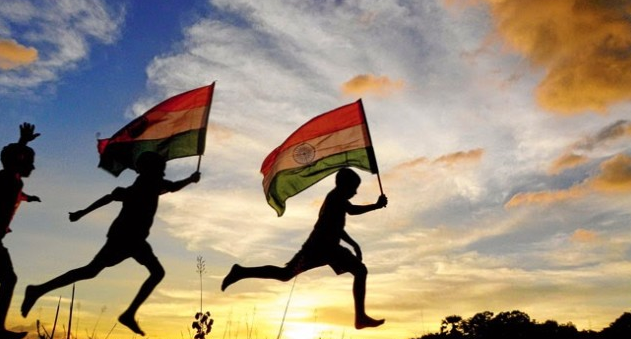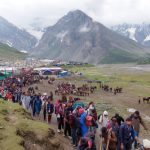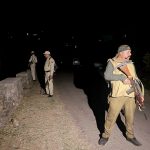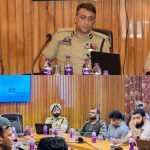To explore the forgotten natural and cultural heritage of the glorious Vishu valley, the District administration Kulgam in collaboration with Indra Gandhi National centre for Arts New Delhi, recently held a maiden two day literary festival titled as Veshu literary festival, at its superb location of Mini secretariat Kulgam overlooking the green forests of the Chambagund and Malwan forest range. During the festivity multipurpose functions and sessions related with heritage, literature, art and music were held at this site. Perhaps it is first time in the history of Kulgam district that such a grand festival was held.
Indeed for holding of such a median literary and cultural festival that too in a shortest period of time, the District administration Kulgam and Indra Gandhi national Centre for Arts New Delhi efforts needs to be appreciated. Although I did not figured in the list of the invitees but since my friend Dr. Satish Vimal, the most prominent Broadcaster, poet and critic was invited to this grand function so to see him I also got a chance to visit this venue. In his loving, literary and intellectual accompany I also attended its few literary sessions, but the most impressive event which attracted the attention of most of its visitors was the live ‘Manzir kashi’ of the rural life of the early nineties of this glorious valley.
This miniature live imagining of rural segment of the early nineties was the most impressive one. The miniature mud houses, mud kitchens, wooden doors and windows depicted the olden architectural traditions of this valley. The live performing of the little student artists with the classical kitchen wares, rice grinders, milk shaking, mat making, water pitchers and fish selling and agricultural tools was the most impressive segment of this festivity. This was a well directed and well performed show and for a moment it looked as if I was travelling in any ancient locality where people looked busy in their day to day activities. The director and performing student artists deserved the best rewards. They not only entrained the audience but made them to travel into villages of 19ths and 18th century. I could also see few little stalls laid by government departments and by few private entrepreneurs, related with Kashmir arts, crafts and literature. Indeed I could also see the several pictures where in the glorious natural heritage sites of the upper Vishu valley had been displayed.
During my observation of this show I also felt that certain significant things were also missing of this valley that was about its history, archaeology and mystic heritage. The script writer of this festival has almost forgotten this important field of this valley. I could not see any such visual or picture or any sort of information about the mystic and archaeology heritage of this valley. In fact Vishu valley besides carrying rich natural heritages, also showcases the wonderful, Spiritual, archaeological architectural heritage legacy. But either there was very little of it or nothing of it displayed in this grand event. I do not know if it was part of this festival or not. Since the glorious Vishu valley is located in the lap of Pir panchal towards the south- west of Kashmir and to the left of Jammu and Kashmir national high way NH IA and about 70 km distant from the summer capital of Srinagar. The valley is approached by well macadamized roads from east, west and northern sides while its southern side is guarded by the peaks of Pir Panchal. This valley extends from the spiritual town of Qaimoh in the east and is spread over a distance of about 150 Km on the either sides of Nallah Vishu upto Kousarnag in the west.
The antiquity of this valley goes thousands of years back as stray finds of Paleolithic and Neolithic tools had also been encountered from this valley, but most of these finds have gone unnoticed and unrecorded. Interestingly in the recent times its antiquity was re- established when a group of teachers of School education department claimed to have encountered the evidences of fossil deposits from its upper reaches. Indeed there is no report of any systematic and scientific geological and archaeological survey of this valley recorded in any archaeological and geological literature, but there are few stray evidences of major archaeological finds of this valley recorded in the archaeological survey reports.
One of such major archaeology discovery is recorded from one of its historical town of Devesar, which is situated on the right bank of Nallah Vishu. Devesar, or the ancient Devesarasa as recorded in ancient records has been the ancient seat of learning and a centre of Kashmir bronze art, influenced by the world famous ancient Ghandahara art. The site is recorded to have revealed few magnificent antiquities of bronze art which included the exquisite sculpture of Lord Buddha of Kushan era and Shankervarmen’s bronze frame of 10th century AD. The Sculpture is well draped and looks as if it wears an olden kashmiri Chhader. The bronze frame locally known as barputh (door) depicts thirty three incarnations of Vishnu Avatar which is sacred to our Hindu brothers.
These artifacts are the masterpieces of ancient Bronze art of Kashmir and stand these days showcased in the Archaeology gallery of the SPS Museum at a Lalmandi in Srinagar. These have become the zenith of this historical museum and have been attracting tourists from far-off lands. These are not only mentioned in the local archaeology and museum records but these two artifacts have been mentioned in the international archaeology and art literatures.(these two artifacts are also recorded to have represented Kashmir art in several international art festivals held from time to time in Russia, USA and France).
There are other several archaeological mounds located in this valley at Kotebal and Kousarbal on the right bank of the Nallah Vishu, but these mounds are yet face any archaeological exploration. Above all these things , this valley is the aboard of ancient mysticism and still showcases wonderful treasure of spiritual and architectural heritage, in fact the Reshi order, one of most popular form of Kashmir mysticism was also founded in this valley with the birth of Nundreshi better known as Shiekh ul Alam, the patron saint of Kashmir in the 14th century AD. Whether Nundreshi was born at Khee Jogipura or at Qaimoh, in both cases he belongs to this valley because both these places are located in this valley. He is known to have spent his childhood at Qaimoh in paragana Ardwani.
There are very interesting and mysterious events of the saint’s early life and teachings preserved in the local oral traditions and folklore of this valley particularly at Khee and Qaimoh localities. Besides there are scores of spiritual sites associated with this sanit found in this valley, which included the mysterious spring at Khee Jogi pora, underground cave at Gufabal, tombs of his family at Qaimoh and his most famous meditation site at Tismer, located in the feet of Hounhang hill rock .
It was at the cave of Gufabal the saint is leant to have got enlightenment of God and thereby he proceeded towards Tismer where he made more mediation in the blue green forests ( when I once visited the site there I could see the grinding stone used by the saint for his vegetations ). These days a well preserved Reshi shrine in the name of saint is most attractive site of this town.
In kashmir valley, hardly there is any such village where there exists no mystic shrine or any relic associated with its mystic culture. There are hundreds of Sufi and Syed shrines found in this valley which symbolize the Reshi order of spiritual architecture, but the main and grand ornamented spiritual shrine is located on the left bank of Vishu in the main town of Kulgam. This shrine belongs to Mir Syed Hussain Semanani the most famous syed saint and missionary, who is learnt to have entered Kashmir with his family and hundreds of other nobles during the period of Sultan Shahab Ud Din and settled at Ammanoo- Kulgam. I could not see any pictutre or any mention of Devesar archaeological finds or of the site, I could also not see any mention or picture of Mata Tripur Sundari Khan barni Devesar and Mata katyayani Temple Manzgam Noor abad.
I observed the festival was literary and culturally centered festival and its main focus was literature and music, but several celebrated musicians and poets of this valley were not invited but had come on their own. On the other hand I could also see several literary and cultural dignitaries who had been invited to this event did not show up to this festivity. In fact most of the architectural, mystic and archaeology heritage sites did not figure in this festival but the pictures of several natural heritage sites of this valley figured prominently, which included Sarkanch, Brahim Sar, Chher-Sar, Dunth-Sar, Kounsarnag, Dandward, D.K. Marg, Zaig Marg, Haka wass, Chheranbal, Gogal Marg, Chitin, Astan Marg, Kongwatton and Gurwaton.
(The author is archaeologist and freelancer. Email: [email protected])








